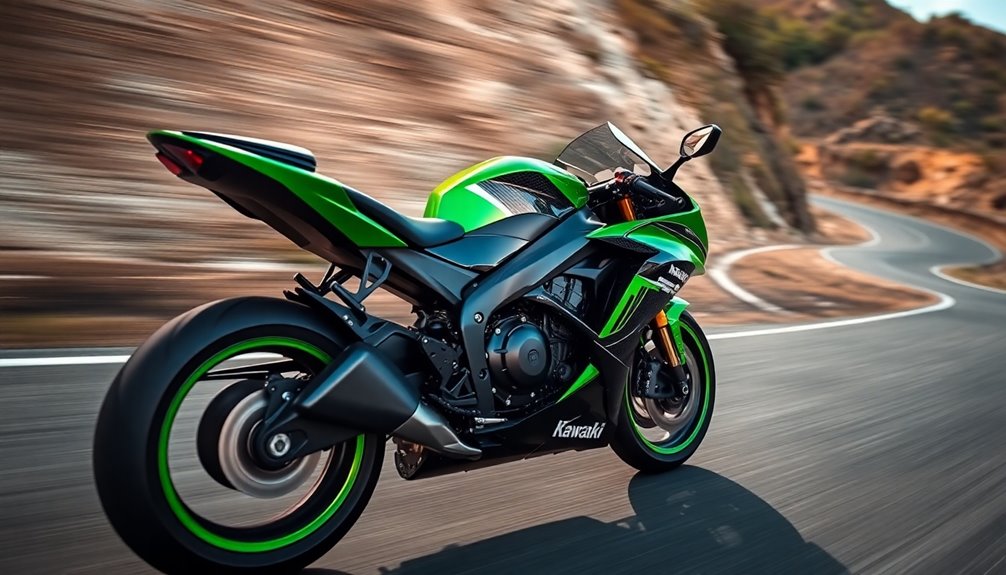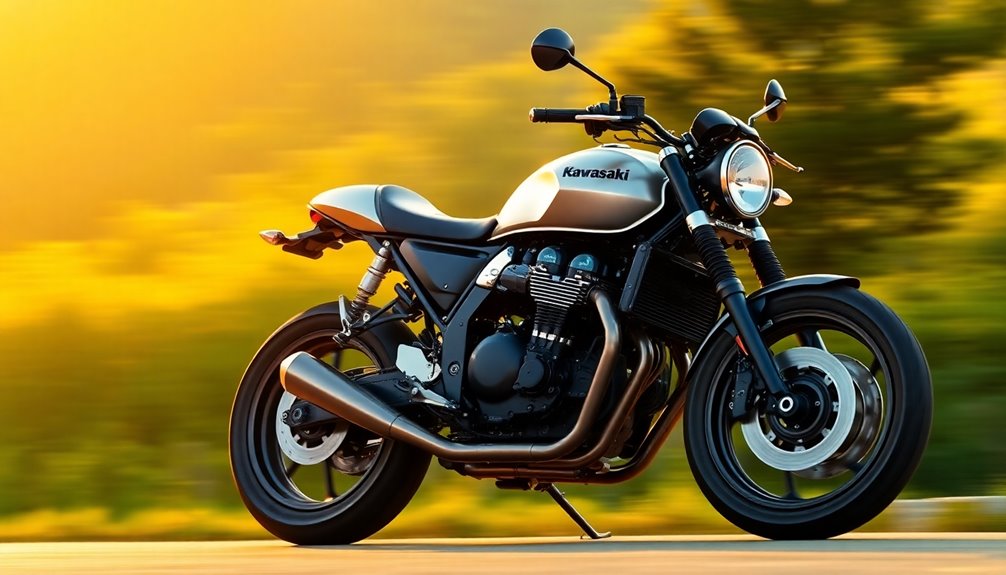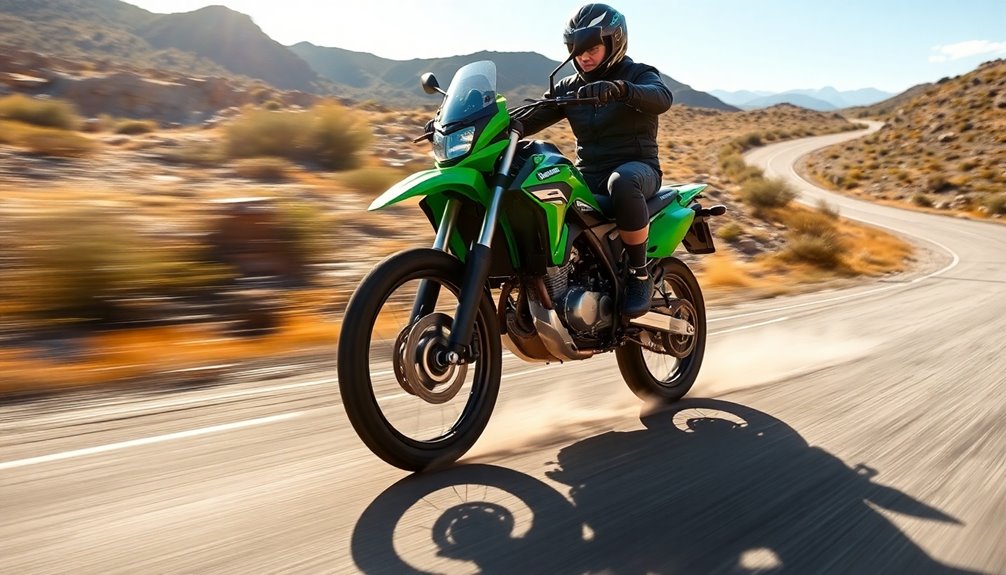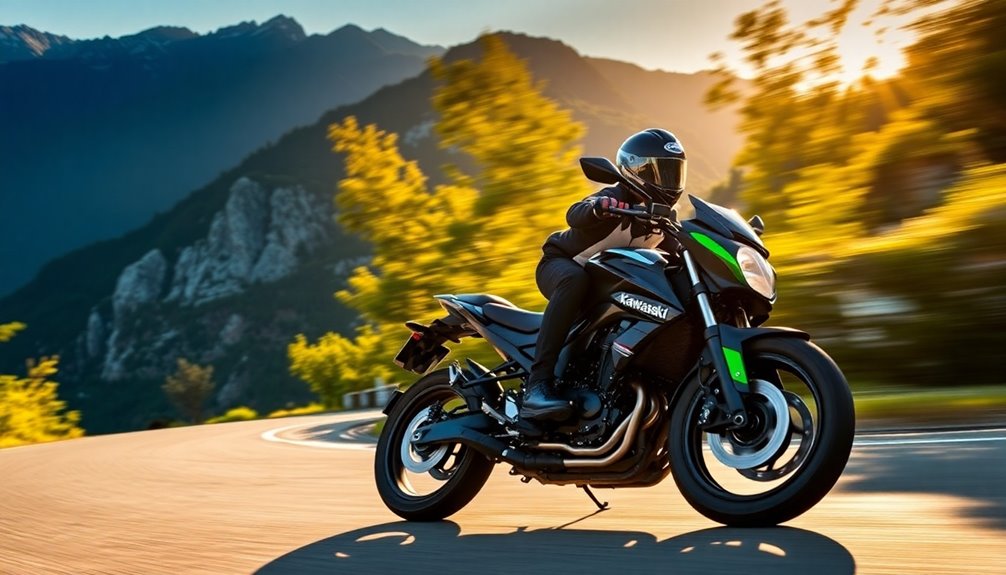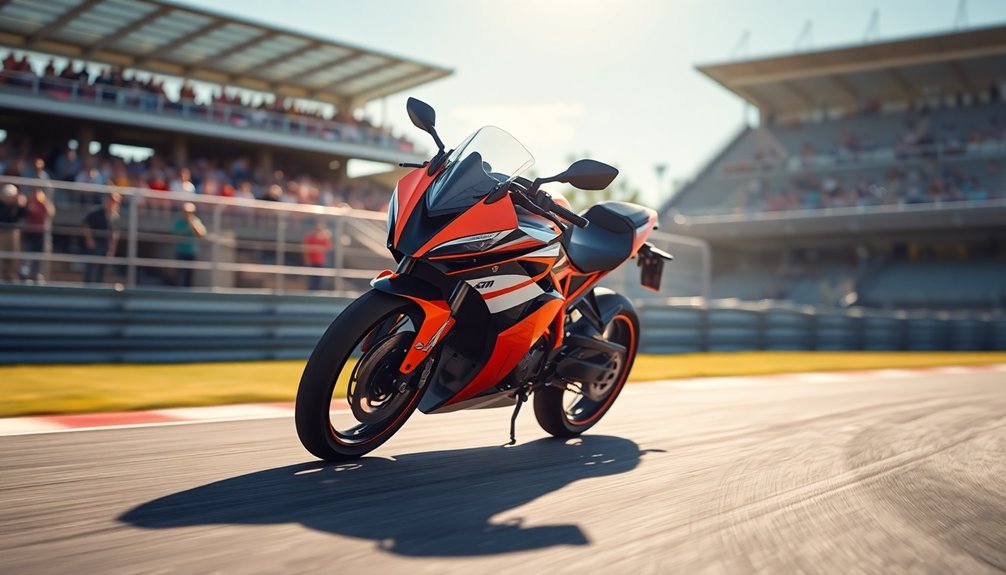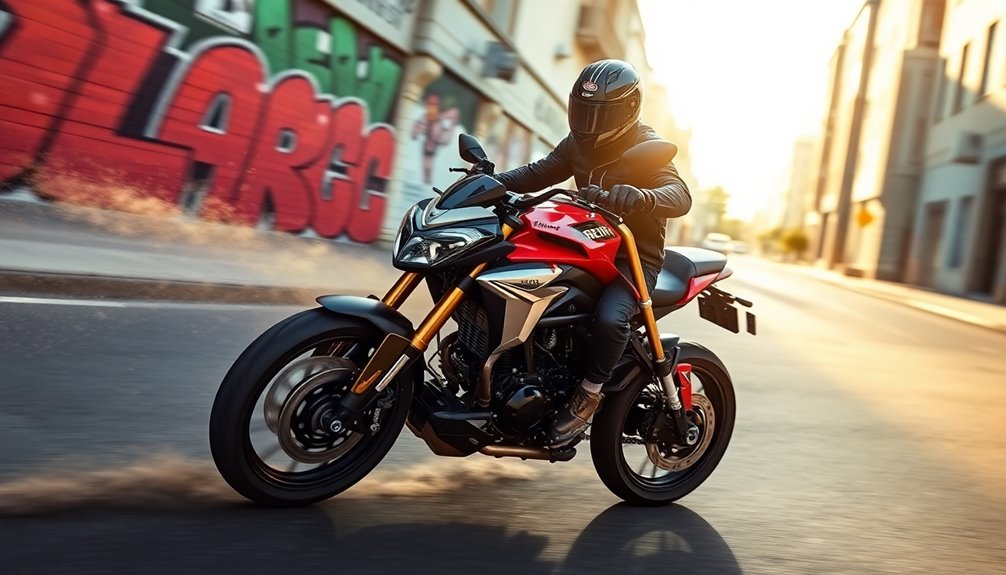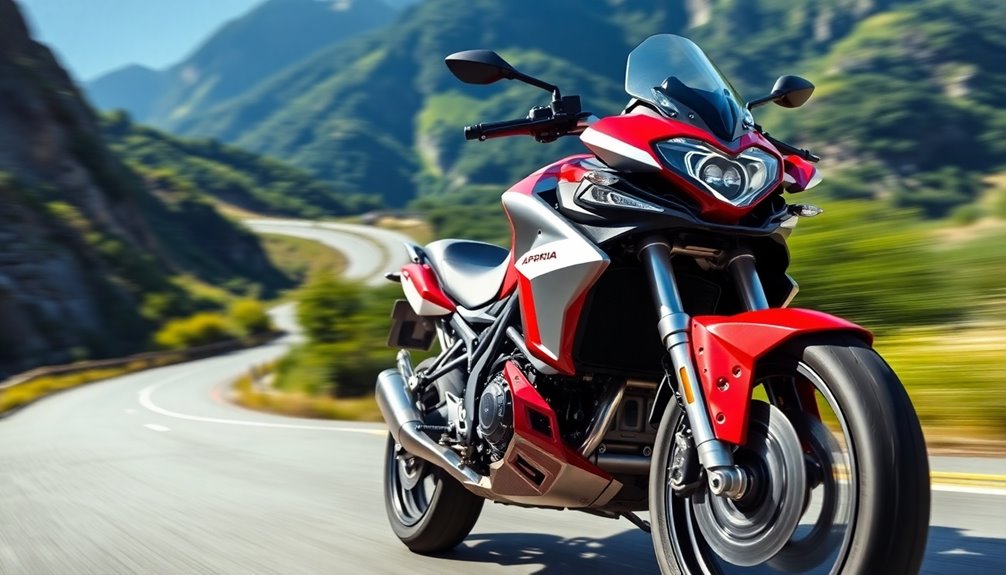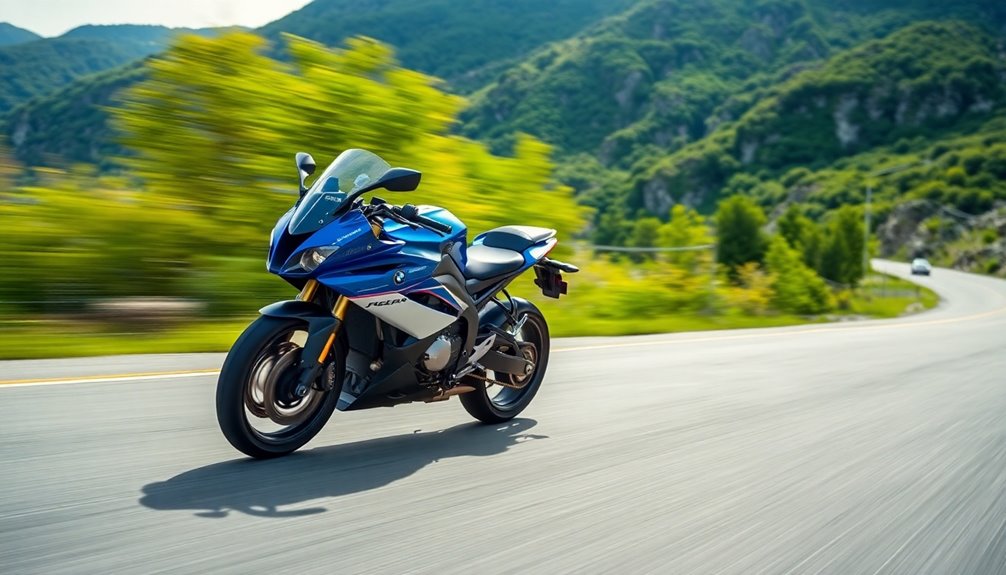The Kawasaki Ninja H2R takes hyperbike performance to staggering heights, boasting a jaw-dropping top speed of 249 mph. Powered by a supercharged 998cc engine, it delivers 310 to 326 horsepower, enabling you to accelerate from 0 to 60 mph in just 3 seconds. Its aerodynamic design enhances stability and downforce, making high-speed riding exhilarating yet controlled. With advanced technology like Kawasaki Traction Control and a quick shifter, this bike ensures optimal performance in various conditions. If you're eager to uncover more about its impressive features and ownership experience, there's plenty more to explore.
Key Takeaways
- The Kawasaki Ninja H2R achieves a remarkable top speed of 249 mph, making it one of the fastest production motorcycles available.
- Its 998cc supercharged engine produces up to 326 horsepower, providing exhilarating acceleration and performance.
- The bike can accelerate from 0-60 mph in approximately 3 seconds, showcasing its impressive speed capabilities.
- Advanced aerodynamics, including carbon-fiber wings, enhance stability and reduce drag at high speeds.
- Specialized tires, such as Bridgestone Racing Battlax V01 slicks, are designed for optimal performance and stability during high-speed riding.
Aerodynamic Design Enhances Stability
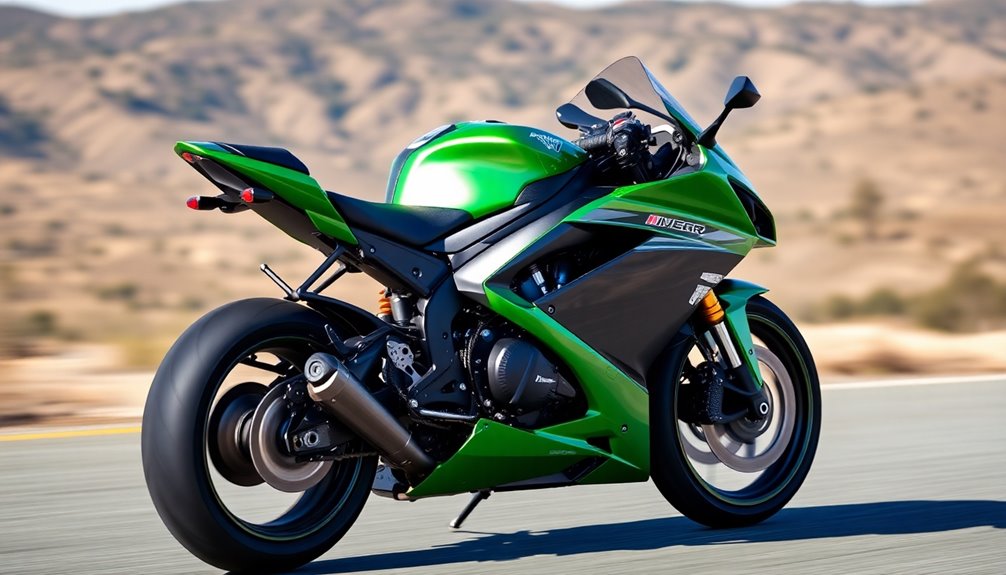
The Kawasaki Ninja H2R's aerodynamic design plays a crucial role in enhancing stability, especially at high speeds. You'll notice how the carbon-fiber vortex down control wings, crafted by KHI's Aerospace Division, smooth airflow around the wingtips. These angled winglets, along with strakes, generate significant downforce without adding much drag, mimicking airplane designs. The chin spoiler further boosts downforce, giving you that extra edge in stability.
As you push past 300 km/h, the aerodynamics really shine. The design reduces lift, ensuring your bike maintains solid contact with the ground. This stability is essential for confident handling, allowing you to navigate curves and straightaways with precision. The Ninja H2R is equipped with a high-RPM supercharger, which adds to its remarkable performance characteristics.
The highly rigid carbon-fiber upper cowl and the aerodynamically shaped rear cowl efficiently direct airflow, minimizing resistance while optimizing cooling performance. Through total-vehicle CFD analysis, Kawasaki fine-tuned these components to enhance overall riding dynamics.
You can feel the difference in rider comfort, too, as the aerodynamic devices prevent turbulence from disturbing your ride. With every angle crafted for performance and style, the Ninja H2R's aerodynamic design truly elevates your high-speed experience.
Exploring Engine Output Potential
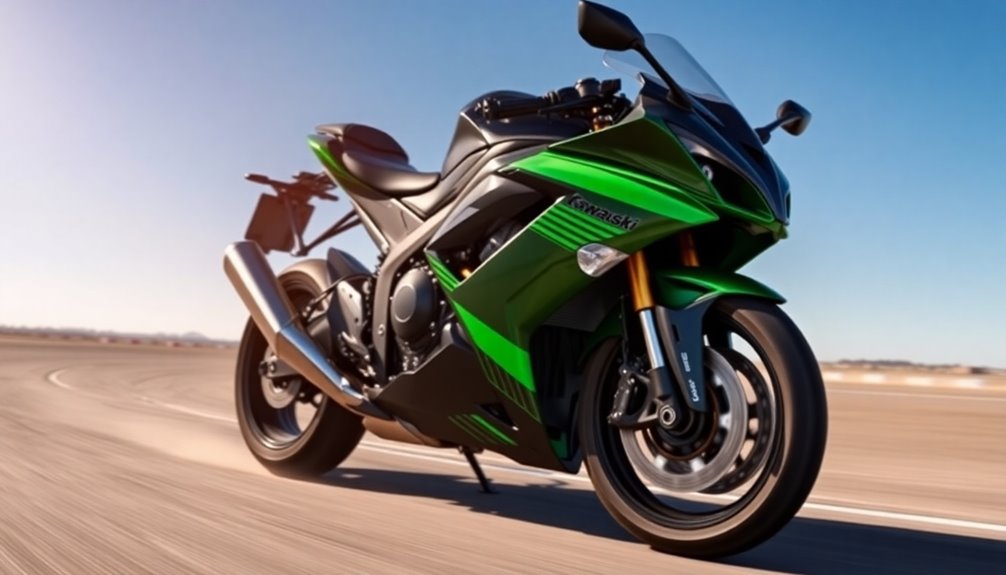
When you tap into the Kawasaki Ninja H2R's power, you'll quickly realize it can exceed 200 mph with ease. The rapid throttle response makes it feel like an extension of yourself, while the right tire grip ensures you stay connected to the road. Together, these elements create an exhilarating riding experience that pushes the limits of performance. With its two-speed centrifugal supercharger, the H2R delivers unprecedented acceleration that enhances the thrill of every ride.
Over 200 Mph Capability
Kawasaki's engineering marvel, the Ninja H2R, showcases astonishing engine output potential, allowing it to exceed 200 mph with ease.
At its core, the H2R features a 998cc, liquid-cooled, 4-stroke, DOHC 16-valve in-line four engine, supercharged with a two-speed centrifugal supercharger. This combination results in a staggering peak power of 310 to 326 horsepower, especially with ram-air engaged.
You'll appreciate how it achieved record speeds, including 248 mph on the Osman Gazi Bridge, and 216 mph during a standing mile test. The H2R boasts over 300 horsepower, significantly higher than standard superbikes.
With an impressive 0-60 mph time of around 3 seconds and a quarter-mile completed in under 10 seconds, the H2R's acceleration is simply jaw-dropping.
However, it's important to note that achieving these speeds requires specific gearing adjustments, as stock gearing limits its maximum potential.
Theoretical top speeds can exceed 250 mph under optimal conditions, but you'll need to push beyond 125 mph to tap into the engine's full power.
Despite power tail-off at around 13,000 rpm, the Ninja H2R remains a titan of speed and performance in the world of hyperbikes.
Rapid Throttle Response
Achieving top speeds isn't just about raw power; rapid throttle response plays a significant role in harnessing that performance. The Kawasaki Ninja H2R features a supercharged 998 cc engine that delivers a staggering 310 horsepower at 14,000 rpm. Its electronic throttle control offers a linear initial response for the first quarter turn, allowing you to smoothly engage the throttle. However, the action becomes progressively quicker throughout the rest of the throttle range, which can be exhilarating or challenging, especially at high lean angles.
If you're an experienced rider, you might notice a jolt when the engine picks up, which can disrupt your smooth cornering lines. This response differs from other high-powered bikes, so you may need to adjust your riding style. Throttle response issues can be mitigated by adjusting the throttle play to eliminate unnecessary slack, contributing to a smoother throttle response. Utilizing Kawasaki's traction control settings can also influence how the throttle feels, particularly if you run it at level #2. Regular maintenance is crucial for optimal performance, ensuring you can fully appreciate the H2R's rapid throttle response.
Ultimately, understanding these characteristics will help you maximize your ride and unleash the full potential of this mind-boggling hyperbike.
Tire Grip and Composition
Tire grip is crucial for unlocking the full potential of the Kawasaki Ninja H2R's extraordinary engine output. To achieve stability at speeds exceeding 350 km/h, Kawasaki partnered with Bridgestone to develop specialized Racing Battlax V01 slicks. These tires incorporate advanced MotoGP technology, ensuring they can withstand the immense forces generated by the H2R's supercharged engine. Additionally, suspension upgrades from the motorcycle tuning industry can further enhance the overall performance and stability at high speeds.
The tire design optimizes case rigidity and modifies shape, providing necessary support while maintaining a balance between the trellis frame and tire. The front tire offers neutral handling, while the rear is tuned specifically for high-speed performance. This combination ensures that even at over 300 km/h, you experience durability and stability. Additionally, the H2R's 310 HP at 14,000 RPM allows for acceleration that demands tire performance at extreme levels.
Constant temperature monitoring during testing guarantees that the tires won't overheat, preventing tread disintegration during extreme conditions. The integrated design considers the vehicle's behavior, ensuring stable contact pressure with the road surface.
This meticulous attention to tire composition and behavior allows you to fully exploit the H2R's power, enhancing both your safety and overall experience. So, when you hit the throttle, you'll know that your tires are ready to handle the adrenaline-pumping speed and performance the Ninja H2R promises.
Rider Comfort at High Speeds

At extreme speeds, rider comfort becomes crucial for maintaining control and enjoyment on the Kawasaki Ninja H2R. The bike's aerodynamic design, featuring wings and spoilers, generates downforce, which keeps the front wheel firmly planted on the ground. This minimizes lift and enhances stability, even when you're pushing beyond 300 km/h.
The suspension system is another key aspect of your comfort. With an Öhlins TTX36 rear shock and KYB AOS-II forks, you'll experience precise damping and adjustable settings, allowing you to tailor the ride to your preference. This combination provides smooth handling and optimal feedback, ensuring you stay in control during high-speed maneuvers. Additionally, the Ninja H2R's lightweight trellis frame contributes to its overall handling characteristics, allowing for nimble responses in tight corners.
Braking performance also plays a significant role in rider comfort. The Ninja H2R comes equipped with dual Brembo Stylema® calipers and a sophisticated anti-lock braking system. This setup offers serious stopping power, reducing the risk of wheel chatter during rapid downshifts.
Lastly, the electronic assistance features, including the KTRC, adapt to various riding conditions, enhancing traction and stability. With these technologies working together, you'll find that the Ninja H2R is designed not just for speed but for your comfort at those exhilarating velocities.
Owner Experiences and Insights

Many owners of the Kawasaki Ninja H2R frequently share their awe-inspiring experiences, particularly regarding the bike's unmatched power and acceleration.
You'll feel the rush as it rockets from 0-100 kph in just 3.1 seconds and reaches 200 kph in a mere 7.2 seconds. The exhilarating sensation of hitting an indicated 200 mph before braking for the first corner is something you won't forget.
Owners often describe the handling as surprisingly forgiving, even with aggressive throttle inputs, thanks to advanced rider aids like traction and wheelie control. The bike's lightweight design contributes significantly to its agility and stopping power, enhancing the overall riding experience.
Maintaining this powerhouse requires commitment, as service intervals are stringent. You'll need to adhere to specific warm-up procedures to ensure optimal performance.
Many riders have noted that the specialized care the H2R demands is well worth it for the thrilling experience it provides.
The bike's design not only looks stunning but also enhances stability at high speeds.
With dual Brembo brake discs and linked ABS, you'll feel confident in your stopping power.
Overall, owners rave about the smooth transmission and dynamic power output, making every ride an unforgettable adventure.
Whether on the track or the open road, the H2R delivers an experience like no other.
Market Position Among Rivals
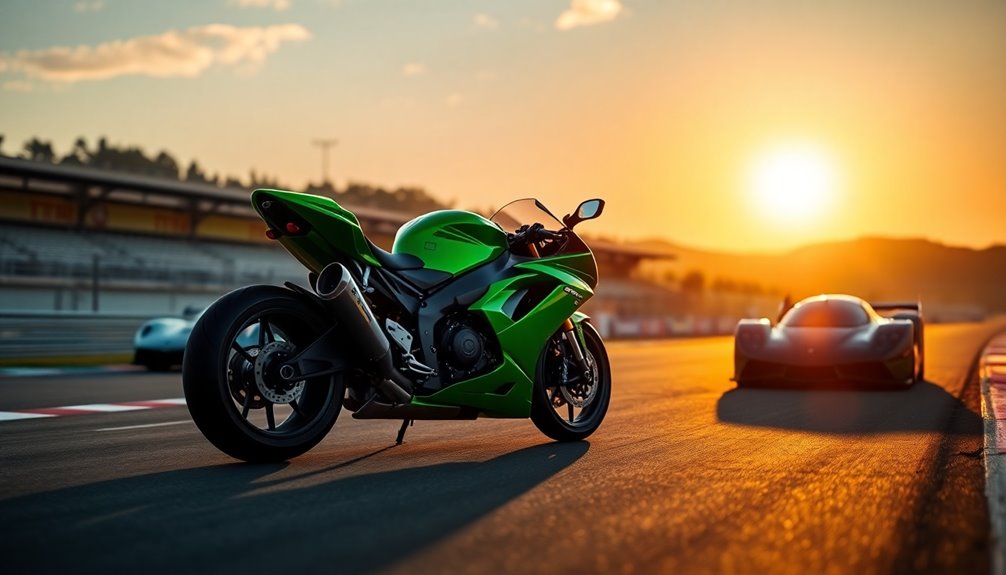
The Kawasaki Ninja H2R stands out in the hyperbike segment, not just for its jaw-dropping performance but also for its unique position among competitors.
With a staggering 310 horsepower and a top speed of 249 MPH, it eclipses rivals like the Honda CBR 1000RR and BMW S 1000 RR, which offer 214.5 and 205 horsepower, respectively.
Unlike these models, the Ninja H2R is exclusively designed for track use, making it less versatile but unmatched in raw speed.
In terms of pricing, the Ninja H2R commands around AUD 80,000, significantly higher than the more accessible BMW S 1000 RR or Ducati Panigale V4. Additionally, the on-road price of the Ninja H2R in New Delhi is around ₹79.9 Lakh, further emphasizing its premium positioning.
This track-only model's limited production adds to its exclusivity, drawing serious enthusiasts but limiting its market reach.
Moreover, the advanced supercharged 998cc engine, along with cutting-edge aerodynamics and electronic aids, puts the Ninja H2R in a league of its own.
While competitors focus on daily usability, the H2R demands high-level riding skills, catering to a niche group that prioritizes extreme performance over practicality.
Powertrain Enhancements for Performance

Powertrain enhancements in the Kawasaki Ninja H2R are engineered to unleash unparalleled performance on the track.
At its core, the motorcycle features a robust 998 cc, liquid-cooled, 4-stroke, DOHC in-line four engine that delivers an astonishing 310 horsepower at 14,000 rpm and torque of 165.0 Nm at 12,500 rpm. This power is complemented by a centrifugal supercharger, designed specifically for motorcycles, which minimizes heat generation while maximizing air intake. The engine's supercharged design allows for improved performance at high speeds.
The Ninja H2R's fuel system utilizes DFI® with four 50mm throttle bodies for precise fuel delivery, supported by a cutting-edge digital ignition system. Additionally, the dual injection system enhances throttle response, allowing you to experience smooth acceleration.
The 6-speed return transmission, equipped with a quick shifter, ensures rapid gear changes, keeping you in the power band for optimal performance.
The wet multi-disc manual clutch and sealed chain final drive work together to provide seamless power transfer to the rear wheel. These powertrain enhancements make the Kawasaki Ninja H2R not just a hyperbike, but a true powerhouse, offering an exhilarating ride that few can match.
Cost and Launch Timeline
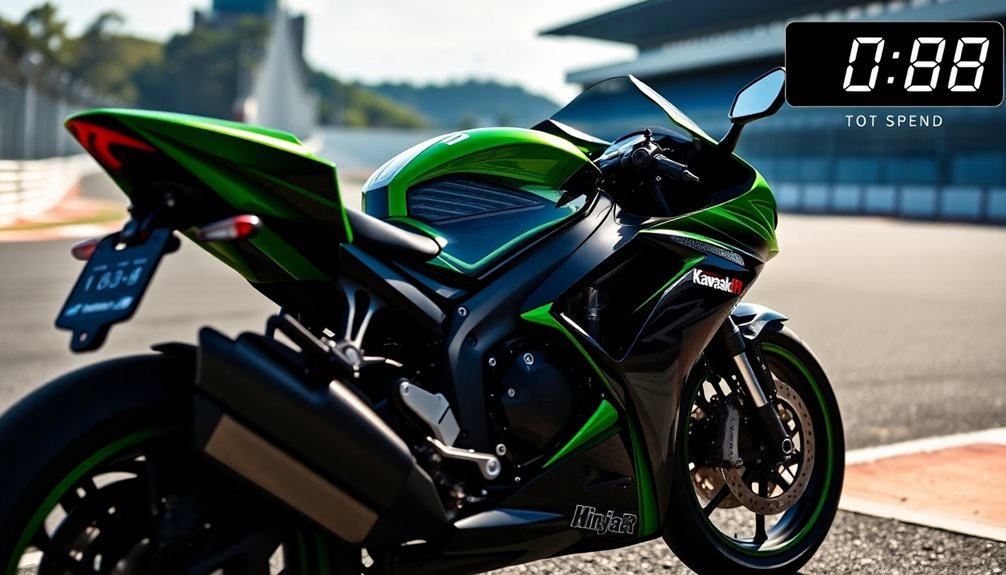
With such a powerhouse of performance, it's no surprise that the Kawasaki Ninja H2R comes with a hefty price tag. Priced at approximately Rs. 79,90,000 (around $98,000 USD), it targets high-end buyers and dedicated performance enthusiasts. This price is significantly higher than other high-performance motorcycles, like the Kawasaki Ninja H2, which costs about $25,000. For some, the value for money may seem questionable, especially given that the H2R is designed exclusively for track use. Keep in mind that there are additional costs to consider, including maintenance, specialized tires, and track fees, which can add up quickly. The Ninja H2R was first announced at the 2014 Intermot motorcycle trade show and made its North American debut at the AIMExpo in October 2014. It officially launched in select markets on August 10, 2018, for the 2019 model year, and is available in various regions, including Europe, the United States, and Australia. Since its release, Kawasaki has provided regular updates and optimizations, enhancing the model's features and performance. The bike features a supercharged 998cc BS6 engine that is integral to its outstanding performance capabilities.
Track-Focused Performance Enthusiasts
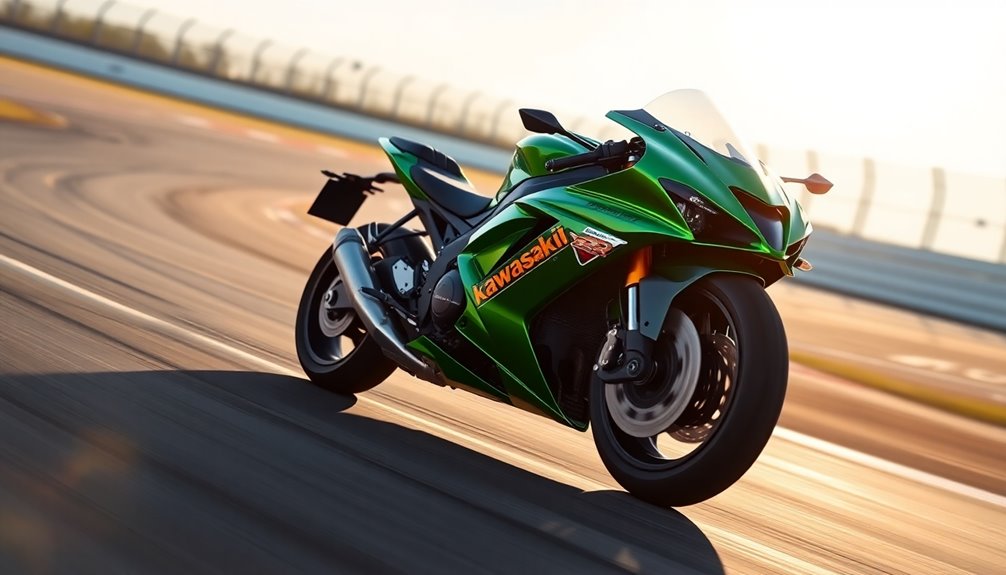
For track-focused performance enthusiasts, the Kawasaki Ninja H2R represents the pinnacle of motorcycle engineering and speed. With its supercharged 998 cc DOHC inline-4 engine, you'll experience an astonishing power output of 326 hp at the crank, translating to about 230-240 hp at the rear wheel. This beast accelerates from 0-60 mph in just 2.93 seconds, making it a formidable contender on any track. Additionally, the Ninja H2R's impressive acceleration metrics, such as 0 – 100 kph in 3.1 seconds, showcase its dominance in the hyperbike category.
Equipped with a premium dog-ring transmission, the H2R offers smooth, precise shifting, ensuring you stay in control during high-speed maneuvers. And with advanced electronics like Kawasaki TRaction Control and wheelie control, you can confidently push the limits without sacrificing stability.
The bike also features an Öhlins TTX36 rear shock and KYB AOS-II fork, allowing you to fine-tune handling to match your riding style. Whether you're tackling tight corners or blasting down straightaways, the H2R's advanced suspension keeps you grounded.
Ultimately, the Ninja H2R isn't just about raw power; it's about delivering an unparalleled track experience that every performance enthusiast craves. Get ready to unleash your full potential on the track!
Frequent Maintenance Requirements
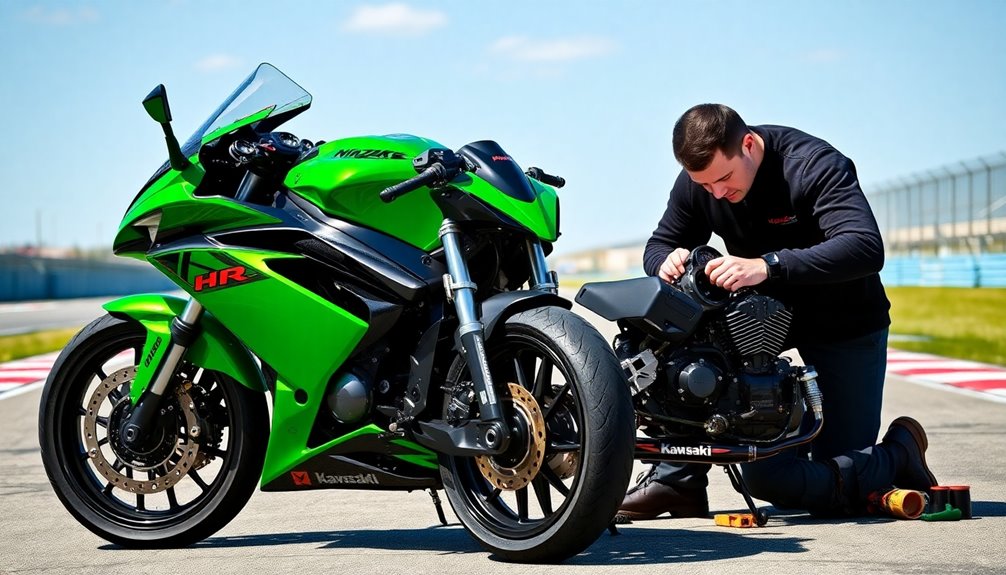
Frequent maintenance is essential for keeping your Kawasaki Ninja H2R performing at its best. Start with oil changes, which are crucial due to the extreme conditions generated by the supercharger. High-stress combustion events necessitate more frequent oil changes, so regularly check and maintain fluid levels to ensure smooth engine operation. Regular oil changes are critical for maintaining engine performance and longevity.
Always use high-quality oil to handle the increased heat and stress; neglecting oil maintenance can lead to serious engine damage.
Next, focus on fuel and octane requirements. The H2R demands premium fuel to prevent detonation and potential engine damage. As boost increases, higher octane fuel becomes even more critical to maintain engine health and performance.
Don't forget about the cooling system. Supercharged engines generate extra heat, making the cooling system vital. The intercooler acts as your main defense against overheating, so keep coolant in top condition and monitor the temperature gauge closely to avoid engine damage.
Finally, pay attention to the chain or belt and transmission maintenance. Regularly lubricate the chain every 300 miles, and remember to replace it every 2,800 miles to keep everything running smoothly.
Following these maintenance requirements will help you enjoy the full potential of your Ninja H2R.
Advanced Braking Systems
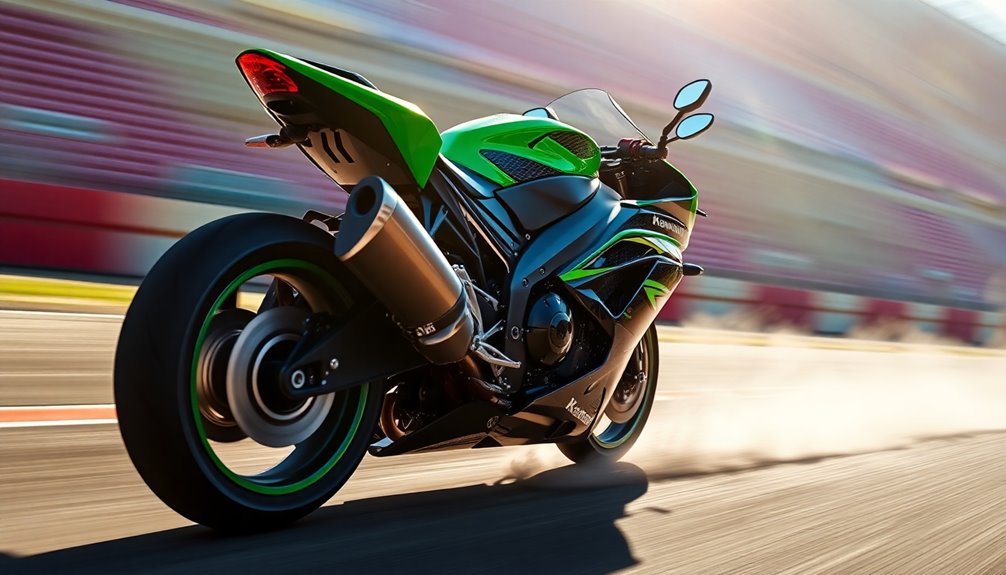
Precision in braking is crucial for maximizing performance on the Kawasaki Ninja H2R, especially at high speeds. The bike's advanced braking system features dual radial-mount opposed 4-piston Brembo Stylema® front calipers paired with semi-floating 330mm front discs, ensuring exceptional stopping power and control.
The 250mm rear disc, equipped with a twin-piston caliper, complements this setup, guaranteeing balanced braking performance.
To enhance your riding experience, the Kawasaki Intelligent Anti-Lock Brake System (KIBS) is included. This supersport-grade system uses high-precision control to modulate brake pressure during aggressive riding.
With its IMU-enabled capabilities, KIBS delivers smooth and accurate braking, even when you're pushing the limits. Additionally, the integration of high-performance components ensures that the braking system can handle the demands of supercharged power effectively.
Additional features like Kawasaki Launch Control Mode (KLCM) help you manage acceleration and braking from a stop, while Kawasaki Engine Brake Control (KEBC) allows you to customize engine braking to your preference.
Vehicle Hold Assist (VHA) engages the rear brake at a stop, offering convenience and comfort.
With advanced electronics and optimized braking hardware, the Ninja H2R's system ensures you maintain precise control, giving you confidence as you tackle the road ahead.
Unmatched Acceleration and Speed
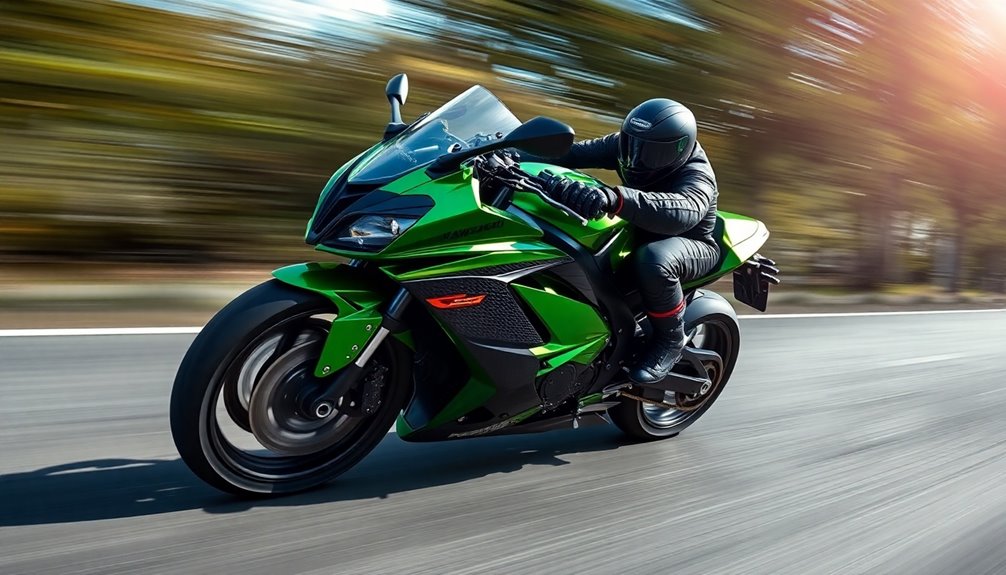
There's no denying that the Kawasaki Ninja H2R delivers unmatched acceleration and speed, making it a standout in the world of superbikes. You can feel the raw power as you launch from 0 to 60 mph in just around 3 seconds.
If you push it further, you'll reach 180 mph in a mere 13.14 seconds over 2,070 feet. Want to go even faster? The Ninja H2R can hit 200 mph with an additional stretch of road in just 16.65 seconds. This incredible performance was recently validated by Motorcycle News during their extensive testing.
This hyperbike boasts a staggering 310 horsepower from its 998cc engine, enhanced by a centrifugal supercharger. It's this unique forced induction that sets it apart, allowing for acceleration rates that outpace even the fastest MotoGP bikes.
The quarter-mile? You'll cover that in under 10 seconds, hitting 151.6 mph along the way. With record speeds like 249 mph, it's clear that the H2R is in a league of its own.
When you twist the throttle, you're not just riding; you're experiencing the pinnacle of motorcycle engineering. The Ninja H2R doesn't just compete; it redefines what's possible on two wheels.
Frequently Asked Questions
What Is the Fuel Capacity of the Kawasaki Ninja H2R?
The fuel capacity of the Kawasaki Ninja H2R is 17.03 liters, which is about 4.50 US gallons.
This amount includes the fuel needed for operation and some reserve, ensuring you can enjoy high-performance riding without constantly worrying about refueling.
It matches the capacity of the street-legal Ninja H2, designed to support the bike's incredible power while balancing weight for optimal performance.
You'll appreciate how this capacity complements the overall riding experience.
How Does the H2R Compare to Other Hyperbikes in Weight?
When you compare the H2R to other hyperbikes, you'll notice it weighs 215.9 kg wet, making it lighter than many competitors.
For instance, the Kawasaki Ninja H2 weighs 240 kg, and the H2 SX SE tips the scales at 260 kg.
Even against track-focused rivals like the Ducati Panigale V4 R, which is around 193 kg dry, the H2R prioritizes performance over absolute weight, showcasing its design for aggressive track use.
What Safety Features Are Included in the H2R Design?
The H2R design incorporates several advanced safety features to enhance your riding experience.
You'll benefit from an Anti-lock Braking System (ABS), traction control, and a slipper clutch, ensuring you stay in control during high-speed rides.
The bike also includes power modes, launch control, and hazard warning indicators, providing you with added security.
With features like a side stand alarm and optional anti-theft alarm, the H2R prioritizes your safety on every ride.
Can the H2R Be Street-Legal With Modifications?
Yes, you can make the H2R street-legal with the right modifications.
You'll need to add headlights, tail lights, and mirrors, and install a compliant exhaust system.
Adjusting the rear tire for street use is essential, too.
While these changes might reduce horsepower slightly, you can still achieve impressive power output.
Just ensure your modifications meet federal and state regulations, balancing performance with legal requirements for a safe, street-ready bike.
What Are the Color Options Available for the Kawasaki Ninja H2R?
When it comes to color options for the Kawasaki Ninja H2R, you'll find it's quite simple.
Since its introduction, the only color available has been Mirror Coated Matte Spark Black.
This consistency in color choice means you won't have to choose from multiple options.
Unlike other Ninja H2 models, which offer various colors, the H2R sticks to this sleek, distinctive design that sets it apart from the rest.
